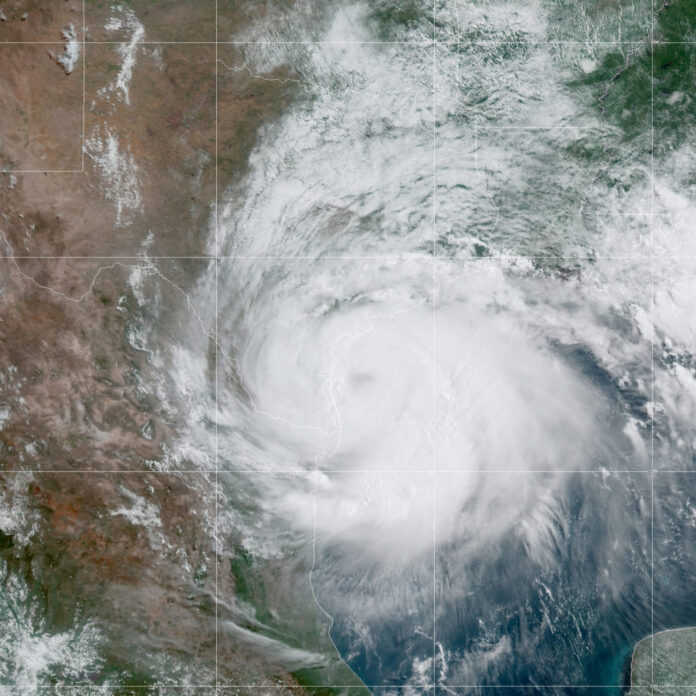Despite all the resources of Hidalgo County being marshaled to deal with the aftermath of Hurricane Hanna, the floodwaters left behind by the storm will linger for at least a week as an overtaxed, overfull drainage system labors to remove the water, officials said.
The news came during a meeting of the Hidalgo County Drainage District No. 1, which reported that some 14 inches of rain battered the most populated areas of the county as the Category 1 storm moved inland between Saturday night and Sunday morning.
Since then, every one of the county’s 26 pumps have been deployed throughout the region to help alleviate the flooding, drainage district General Manager Raul Sesin explained to the Hidalgo County Commissioners Court. Flood control gates throughout the system also remain open to allow maximum flow of water.
“Everything’s open, with the exception, of course, of Panchitas,” Sesin said.
The Panchitas gates “will remain closed.”
Explaining how crews are throttling the flow of that particular gate so as to not overwhelm Willacy County, which was also dealt a severe blow by the hurricane, Sesin added: “We have flow — controlled flow. When I say ‘closed’ is we’re controlling the flow that’s going out of our area so we don’t flood our sister counties.”
Nonetheless, it will still take at least a week before the water here completely subsides. And it will take some time before the water already in the drains and ditches subsides enough for crews to begin pumping out flooded neighborhoods.
Rather than isolated areas experiencing flooding — a city here, or a neighborhood there — Hanna’s rains inundated the entire drainage system, causing several portions to crest and overflow. In the days since, the waters have fallen by 4 to 5 feet, Sesin said.
But, with the entire Rio Grande Valley inundated, and the region’s drains flowing from west to east, the westernmost regions cannot be dewatered until the eastern regions can accommodate that capacity, Sesin said.
Precinct 1 Commissioner David Fuentes asked Sesin what that meant for his Mid-Valley cities, which have now sustained catastrophic flooding over three consecutive summers.
“Being the easternmost part of the county, we’re pretty much the last ones to drain and a lot of our areas are under 2, 3, 4 feet of water in the most vulnerable, low-lying areas. So, do you see that as two more days? Three more days?” Fuentes asked.
“In your area, sir, it’s a little harder to gauge because of those natural low areas. Our east lateral is flowing at full capacity,” Sesin said.
“We anticipate this is being a little bit longer — probably another week or so of full flow, open gates,” he said.
For Fuentes, that response served to emphasize how urgent and critically important the county’s drainage projects — some $190 million worth of infrastructure improvements approved by voters in November 2018, the bulk of which are slated for Precinct 1 — are to mitigating an issue that, increasingly, seems to be the rule rather than the exception.
“I guess these storms are not, you know, just outliers or things we get just every once in a while. I guess we should plan for these things all the time,” Fuentes said.
“Obviously, again, we’ve stressed out on our drains and let’s just plan for the worst case scenario now,” he said.
There was at least one silver lining Tuesday. A few minutes after wrapping up the status update of the drainage district, the commissioners convened an emergency meeting to discuss Hanna-related disaster response expenditures.
Aside from that, however, Jaime Longoria, the executive director of the Community Service Agency, announced the CSA would be providing cash relief to those affected by the storm. The CSA will be able to distribute $300 benefits, Longoria said.
“We know that’s literally just a small token assistance, but given the magnitude and the number of families that have been affected across the county, and given our budget constraints, we’re looking to implement a very short term program of $300,” Longoria said.
The CSA will provide up to $100 for vehicle and clothing expenses, $100 for “food and essentials,” and $100 for residents to purchase cleaning supplies, he said.
The CSA has been instrumental in providing disaster relief in previous storms, including the June 2018 and June 2019 storms. One way they contribute — aside from distributing relief funds — is by providing short term shelter for people displaced from their homes.
Hurricane Hanna proved no different.
Dozens of families have reached out to the CSA so far seeking help after being flooded out of their homes. But this time around, CSA staffers found it particularly difficult finding available hotel space to house those residents — in large part because of the ongoing COVID-19 pandemic, Longoria said.
“It’s a double whammy, commissioner. We have some people that are in hotels because of Covid. We have people that are in hotels because they’re doctors and nurses coming in from out of the area. And then we have some people that self-evacuated and got out of harm’s way,” Longoria said.
The day after the storm, CSA staffers looked as far as east as Mercedes to try to find hotel rooms for families that had been displaced from their homes on the western side of the county, he said.
“We are kinda a little bit over that crunch right now, and we’re able to find a little bit more space,” Longoria said.




